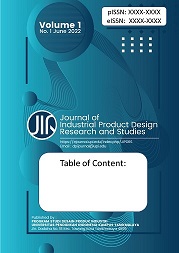Design of Portable Clean Water Storage Facilities for Street Vendors
Abstract
Full Text:
PDFReferences
Ban, K., and Jung, E. S. (2020). Ear shape categorization for ergonomic product design. International Journal of Industrial Ergonomics, 80, 102962.
Campbell, B. M., Vermeulen, S. J., Aggarwal, P. K., Corner-Dolloff, C., Girvetz, E., Loboguerrero, A. M., Ramirez-Villegas, J., Rosenstock, T., Sebastian, L., K. Thornton, P., and Wollenberg, E. (2016). Reducing risks to food security from climate change. Global Food Security, 11, 34-43.
Chih-Pei, H. U., and Chang, Y. Y. (2017). John W. Creswell, research design: Qualitative, quantitative, and mixed methods approaches. Journal of Social and Administrative Sciences, 4(2), 205-207.
Den Hollander, M. C., Bakker, C. A., and Hultink, E. J. (2017). Product design in a circular economy: Development of a typology of key concepts and terms. Journal of Industrial Ecology, 21(3), 517-525.
Fajrin, A. A. T. (2017). Tindakan sosial pedagang angkringan dalam penerapan PHBS (perilaku hidup bersih dan sehat) di Surabaya. Komunitas, 6(1), 23-41.
Fariyanto, F., Suaidah, S., and Ulum, F. (2021). Perancangan aplikasi pemilihan kepala desa dengan metode ux design thinking (studi kasus: Kampung Kuripan). Jurnal Teknologi Dan Sistem Informasi, 2(2), 52-60.
Ginanjar, R., Fathimah, A., and Aulia, R. (2018). Analisis risiko ergonomi terhadap keluhan musculoskeletal disorders (MSDS) pada pekerja konveksi di Kelurahan Kebon Pedes Kota Bogor tahun 2018. Promotor, 1(2), 124-129.
Hartadi, M. G., Swandi, I. W., and Mudra, I. W. (2020). Warna dan prinsip desain user interface (ui) dalam aplikasi seluler “bukaloka”. Jurnal Dimensi DKV Seni Rupa dan Desain, 5(1), 105-119.
Irvan, M. (2015). Fase pengembangan konsep produk dalam kegiatan perancangan dan pengembangan produk. Faktor Exacta, 4(3), 261-274.
Iswandi, H., and Mubarat, H. (2019). Analysis of interpretation on the banner of Lamongan pecel lele. Ekspresi Seni: Jurnal Ilmu Pengetahuan dan Karya Seni, 21(1), 39-55.
Kelley, T. R. (2020). The anatomy of a design brief. Technology and Engineering Teacher, 79(7), 8-12.
Ladhari, R., Souiden, N., and Dufour, B. (2017). The role of emotions in utilitarian service settings: The effects of emotional satisfaction on product perception and behavioral intentions. Journal of Retailing and Consumer Services, 34, 10-18.
Nataprawira, A., and Karya, A. (2013) Sarana pencuci peralatan makan untuk pedagang makanan pinggir jalan. Product Design, 2(1), 1-9.
Puspita, A. A. P. A., Sachari, A., & Sriwarno, A. B. (2016). Dinamika budaya material pada desain furnitur kayu di Indonesia. Panggung, 26(3), 247-260.
Sukerti, N. W., Marsiti, C. I., and Suriani, N. M. (2016). Reinventarisasi makanan tradisional buleleng sebagai upaya pelestarian seni kuliner Bali. Jurnal Ilmu Sosial dan Humaniora, 5(1), 744-753.
Veiga, A., and Weyl, E. G. (2016). Product design in selection markets. The Quarterly Journal of Economics, 131(2), 1007-1056.
Welbourne, L. E., Morland, A. B., and Wade, A. R. (2015). Human colour perception changes between seasons. Current Biology, 25(15), R646-R647.
Wijaya, S. (2019). Indonesian food culture mapping: a starter contribution to promote Indonesian culinary tourism. Journal of Ethnic Foods, 6(1), 1-10.
Yunus, S. P. (2015). Hubungan personal higiene dan fasilitas sanitasi dengan kontaminasi escherichia coli pada makanan di rumah makan padang Kota Manado dan Kota Bitung. Jurnal Ilmu Kesehatan Masyarakat Unsrat, 5(3), 210-220.
DOI: https://doi.org/10.17509/jipdrs.v1i1.47468
Refbacks
- There are currently no refbacks.
Copyright (c) 2022 Universitas Pendidikan Indonesia (UPI)

This work is licensed under a Creative Commons Attribution-ShareAlike 4.0 International License.

This work is licensed under a Creative Commons Attribution-ShareAlike 4.0 International License.


